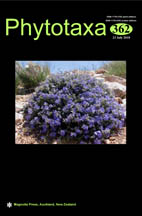Abstract
Salvia ozolotepecensis, S. patriciae and S. sirenis (Lamiaceae) from Oaxaca, Mexico, are described and illustrated as three new species. The first one is characterized by its glandular-capitate pubescence in stems, leaves and inflorescences, mostly persistent floral bracts, entire and 5-veined upper calyx lip, red corolla, epapillate inside, included stamens, and connective ornate with opposed retrorse and antrorse teeth bordering an incision. It is most similar to S. perlonga and S. praestans to which it is compared. The second can be distinguished in having ovate to ovate-deltoid leaf blades, entire, acute and 7-veined upper calyx lips, red corollas, internally ornate near the base with two slender linguiform papillae, upper corolla lip shorter than the lower one, exserted stamens and glabrous style. This new taxon is morphologically similar to the species belonging to Salvia sections Cardinales, Charantia, Incarnatae, Flexuosa, Fulgentes, Iodophyllae and Pedicellata; although, it cannot be unambiguously assigned to one of these. In contrast, S. sirenis clearly belongs to S. sect. Scorodonia; amongst the species therein, the new species can be differentiated by the concolorous leaves, rounded to slightly oblique at base, 6–8-flowered floral nodes, longer floral bracts, pedicels, calyces and corollas, and 5 or 7-veined upper calyx lip. Also, it represents an addition to Mexican Salvia with white corollas. The molecular markers ITS, trnL-trnF and trnH-psbA were sequenced for two of the three new species, and their phylogenetic position is discussed.

